UAV-Assisted Privacy-Preserving Online Computation Offloading for Internet of Things
Abstract
:1. Introduction
1.1. Related Works and Challenges
1.2. Contributions
- We investigate a new privacy leakage issue within the online computation offloading over UAV-assisted IoT, namely computation offloading preference leakage.
- We propose a differential privacy-based deep Q-learning (DP-DQL) method to protect computation offloading preference over UAV-assisted IoT. In the proposed DP-DQL method, the DQL is adopted as the basic framework for efficiently learning computation offloading policy without the a priori knowledge of the wireless channel model. Then, a generated Gaussian noise is generated in the policy updating process of DQL, which can protect the computation offloading preference. Finally, the learning speed of DP-DQL is accelerated by the PER technique [21] by replying the experience with high temporal-difference error.
- We provide theoretical analysis for the differential privacy guarantee and utility loss. Then, the convergence, privacy protection, and cost efficiency of our method is demonstrated by extensive real-world experiments. The results show that our method can help UAV learn the cost-efficient computation offloading policy with the differential privacy guarantee.
2. Materials and Methods
2.1. Background Techniques
2.1.1. Differential Privacy
2.1.2. Deep Q-Learning
2.2. System Model and Problem Formulation
2.2.1. System Model
2.2.2. Threat Model and Privacy Issue
- The BSs can provide customized services for UAV based on the formats of UAV’s computation offloading policy and the inputs of the policy.
- Once the adversary induce the BS, it can monitor the inputs and formats of UAV’s computation offloading policy.
2.2.3. Design Goals
- Differential privacy guarantee: DP-DQL method should provide -differential privacy for UAV during learning process so that the value function of the UAV’s computation offloading policy will not be inferred by the adversaries based on the system state and offloading decision.
- Minor utility loss: DP-DQL method should guarantee that, compared with the traditional DQL method, the performance of the DP-DQL method will not be significantly degraded by adding the differential privacy mechanism.
2.2.4. Problem Formulation
- (1)
- System state: The system state is the offloaded proportion. Formally, ranges from 0 to 1.
- (2)
- Action space: The UAV adjusts the offloaded proportion of a task by increasing or decreasing from 0 to 0.25. Formally, .
- (3)
- Reward function: The weighted average of energy and time costs is adopted as the reward function, which is given as follows:
2.3. DP-Based Deep Q-Learning for Computation Offloading
2.3.1. Overview
- Initialization: Initializing the parameters used in DP-DQL approach.
- Exploring: The UAV executes offloading action and obtains reward from the environment.
- Generating differential disturbance: The UAV generates the specific Gaussian noise to prevent the computation offloading preference leakage.
- PER-based policy updating: The UAV updates computation offloading policy with the help of PER technique.
| Algorithm 1 Differential Privacy-based Deep Q-Learning for computation offloading method |
|
2.3.2. Initialization (Lines 1–4)
2.3.3. Exploring (Lines 5–8)
2.3.4. Generating Differential Disturbance (Lines 9–11)
2.3.5. PER-Based Policy Updating (Lines 12–21)
2.4. Theoretical Analysis
2.4.1. Differential Privacy Guarantee
2.4.2. Minor Utility Loss
3. Results
3.1. Experiment Settings
3.2. Baseline Methods
- Greedy: This method has been widely adopted as a baseline method, where all tasks are fully offloaded to the BSs.
- Deep Q-learning with non-differentially-private mechanism (DQL-non-DP) [19]: We adopt a model-free method designed for healthcare IoT network [19] and adjust it according to the system state space of this paper. This method can learn the cost-efficient computation offloading policy and serve as the baseline of cost efficiency for the DP-DQL method. The DQL-non-DP method shares the same hyperparameters with the DP-DQL method in the following experiments.
3.3. The Convergence of the DP-DQL Method
3.4. The Privacy Protection of the DP-DQL Method
- : The distributions of the vanilla value function is the same as that of recovered value function in the state space .
- : The distributions of the vanilla value function is not the same as that of recovered value function in the state space .
3.5. The Cost Efficiency of the DP-DQL Method
3.6. The Performance of the DP-DQL Method Deployed in a Realistic Scenario
4. Discussion
4.1. Impact of the Key Parameters on the Convergence of DP-DQL Method
4.2. Limitations and Future Works
5. Conclusions
Author Contributions
Funding
Institutional Review Board Statement
Informed Consent Statement
Data Availability Statement
Conflicts of Interest
References
- Fraga-Lamas, P.; Ramos, L.; Mondéjar-Guerra, V.M.; Fernández-Caramés, T.M. A Review on IoT Deep Learning UAV Systems for Autonomous Obstacle Detection and Collision Avoidance. Remote Sens. 2019, 11, 2144. [Google Scholar] [CrossRef] [Green Version]
- Qiu, T.; Chi, J.; Zhou, X.; Ning, Z.; Atiquzzaman, M.; Wu, D.O. Edge Computing in Industrial Internet of Things: Architecture, Advances and Challenges. IEEE Commun. Surv. Tutor. 2020, 22, 2462–2488. [Google Scholar] [CrossRef]
- Zhou, F.; Hu, R.Q.; Li, Z.; Wang, Y. Mobile Edge Computing in Unmanned Aerial Vehicle Networks. IEEE Wirel. Commun. 2020, 27, 140–146. [Google Scholar] [CrossRef] [Green Version]
- Hong, Z.; Chen, W.; Huang, H.; Guo, S.; Zheng, Z. Multi-Hop Cooperative Computation Offloading for Industrial IoT-Edge-Cloud Computing Environments. IEEE Trans. Parallel Distrib. Syst. 2019, 30, 2759–2774. [Google Scholar] [CrossRef]
- Chen, W.; Zhang, Z.; Hong, Z.; Chen, C.; Wu, J.; Maharjan, S.; Zheng, Z.; Zhang, Y. Cooperative and Distributed Computation Offloading for Blockchain-Empowered Industrial Internet of Things. IEEE Internet Things J. 2019, 6, 8433–8446. [Google Scholar] [CrossRef]
- Dai, Y.; Zhang, K.; Maharjan, S.; Zhang, Y. Deep Reinforcement Learning for Stochastic Computation Offloading in Digital Twin Networks. IEEE Trans. Ind. Inform. 2021, 17, 4968–4977. [Google Scholar] [CrossRef]
- Ren, Y.; Sun, Y.; Peng, M. Deep Reinforcement Learning Based Computation Offloading in Fog Enabled Industrial Internet of Things. IEEE Trans. Ind. Inform. 2021, 17, 4978–4987. [Google Scholar] [CrossRef]
- Yang, L.; Li, M.; Si, P.; Yang, R.; Sun, E.; Zhang, Y. Energy-Efficient Resource Allocation for Blockchain-Enabled Industrial Internet of Things with Deep Reinforcement Learning. IEEE Internet Things J. 2021, 8, 2318–2329. [Google Scholar] [CrossRef]
- Pan, X.; Wang, W.; Zhang, X.; Li, B.; Yi, J.; Song, D. How You Act Tells a Lot: Privacy-Leaking Attack on Deep Reinforcement Learning. In Proceedings of the International Foundation for Autonomous Agents and Multiagent Systems, AAMAS 2019, Montreal, QC, Canada, 13–17 May 2019; pp. 368–376. [Google Scholar]
- Zhou, C.; Wu, W.; He, H.; Yang, P.; Lyu, F.; Cheng, N.; Shen, X. Deep Reinforcement Learning for Delay-Oriented IoT Task Scheduling in SAGIN. IEEE Trans. Wirel. Commun. 2021, 20, 911–925. [Google Scholar] [CrossRef]
- Liu, P.; He, H.; Fu, T.; Lu, H.; Alelaiwi, A.; Wasi, M.W.I. Task offloading optimization of cruising UAV with fixed trajectory. Comput. Netw. 2021, 199, 108397. [Google Scholar] [CrossRef]
- Wei, D.; Ma, J.; Luo, L.; Wang, Y.; He, L.; Li, X. Computation offloading over multi-UAV MEC network: A distributed deep reinforcement learning approach. Comput. Netw. 2021, 199, 108439. [Google Scholar] [CrossRef]
- Zhu, S.; Gui, L.; Zhao, D.; Cheng, N.; Zhang, Q.; Lang, X. Learning-Based Computation Offloading Approaches in UAVs-Assisted Edge Computing. IEEE Trans. Veh. Technol. 2021, 70, 928–944. [Google Scholar] [CrossRef]
- Seid, A.M.; Boateng, G.O.; Anokye, S.; Kwantwi, T.; Sun, G.; Liu, G. Collaborative Computation Offloading and Resource Allocation in Multi-UAV-Assisted IoT Networks: A Deep Reinforcement Learning Approach. IEEE Internet Things J. 2021, 8, 12203–12218. [Google Scholar] [CrossRef]
- Sacco, A.; Esposito, F.; Marchetto, G.; Montuschi, P. Sustainable Task Offloading in UAV Networks via Multi-Agent Reinforcement Learning. IEEE Trans. Veh. Technol. 2021, 70, 5003–5015. [Google Scholar] [CrossRef]
- Gao, A.; Wang, Q.; Chen, K.; Liang, W. Multi-UAV Assisted Offloading Optimization: A Game Combined Reinforcement Learning Approach. IEEE Commun. Lett. 2021, 25, 2629–2633. [Google Scholar] [CrossRef]
- He, X.; Liu, J.; Jin, R.; Dai, H. Privacy-Aware Offloading in Mobile-Edge Computing. In Proceedings of the 2017 IEEE Global Communications Conference (GLOBECOM 2017), Singapore, 4–8 December 2017; pp. 1–6. [Google Scholar]
- He, X.; Jin, R.; Dai, H. Physical-Layer Assisted Privacy-Preserving Offloading in Mobile-Edge Computing. In Proceedings of the 2019 IEEE International Conference on Communications (ICC 2019), Shanghai, China, 20–24 May 2019; pp. 1–6. [Google Scholar]
- Min, M.; Wan, X.; Xiao, L.; Chen, Y.; Xia, M.; Wu, D.; Dai, H. Learning-Based Privacy-Aware Offloading for Healthcare IoT with Energy Harvesting. IEEE Internet Things J. 2019, 6, 4307–4316. [Google Scholar] [CrossRef]
- He, X.; Jin, R.; Dai, H. Deep PDS-Learning for Privacy-Aware Offloading in MEC-Enabled IoT. IEEE Internet Things J. 2019, 6, 4547–4555. [Google Scholar] [CrossRef]
- Schaul, T.; Quan, J.; Antonoglou, I.; Silver, D. Prioritized Experience Replay. In Proceedings of the 4th International Conference on Learning Representations, (ICLR 2016), San Juan, Puerto Rico, 2–4 May 2016. [Google Scholar]
- Dwork, C.; McSherry, F.; Nissim, K.; Smith, A.D. Calibrating Noise to Sensitivity in Private Data Analysis. Lecture Notes in Computer Science. In Proceedings of the Theory of Cryptography, Third Theory of Cryptography Conference, TCC 2006, New York, NY, USA, 4–7 March 2006; Springer: Berlin/Heidelberg, Germany, 2006; Volume 3876, pp. 265–284. [Google Scholar]
- Dwork, C.; Roth, A. The Algorithmic Foundations of Differential Privacy. Found. Trends Theor. Comput. Sci. 2014, 9, 211–407. [Google Scholar] [CrossRef]
- Mnih, V.; Kavukcuoglu, K.; Silver, D.; Rusu, A.A.; Veness, J.; Bellemare, M.G.; Graves, A.; Riedmiller, M.A.; Fidjeland, A.; Ostrovski, G.; et al. Human-level control through deep reinforcement learning. Nature 2015, 518, 529–533. [Google Scholar] [CrossRef] [PubMed]
- Messous, M.A.; Senouci, S.; Sedjelmaci, H.; Cherkaoui, S. A Game Theory Based Efficient Computation Offloading in an UAV Network. IEEE Trans. Veh. Technol. 2019, 68, 4964–4974. [Google Scholar] [CrossRef]
- Li, K.; Tao, M.; Chen, Z. Exploiting Computation Replication for Mobile Edge Computing: A Fundamental Computation-Communication Tradeoff Study. IEEE Trans. Wirel. Commun. 2020, 19, 4563–4578. [Google Scholar] [CrossRef] [Green Version]
- Zhou, F.; Hu, R.Q. Computation Efficiency Maximization in Wireless-Powered Mobile Edge Computing Networks. IEEE Trans. Wirel. Commun. 2020, 19, 3170–3184. [Google Scholar] [CrossRef] [Green Version]
- Tiwari, N.; Bellur, U.; Sarkar, S.; Indrawan, M. CPU Frequency Tuning to Improve Energy Efficiency of MapReduce Systems. In Proceedings of the 2016 IEEE 22nd International Conference on Parallel and Distributed Systems (ICPADS), Wuhan, China, 13–16 December 2016; pp. 1015–1022. [Google Scholar]
- He, X.; Jin, R.; Dai, H. Peace: Privacy-Preserving and Cost-Efficient Task Offloading for Mobile-Edge Computing. IEEE Trans. Wirel. Commun. 2020, 19, 1814–1824. [Google Scholar] [CrossRef]
- Min, M.; Xiao, L.; Chen, Y.; Cheng, P.; Wu, D.; Zhuang, W. Learning-Based Computation Offloading for IoT Devices with Energy Harvesting. IEEE Trans. Veh. Technol. 2019, 68, 1930–1941. [Google Scholar] [CrossRef] [Green Version]
- Chen, X.; Jiao, L.; Li, W.; Fu, X. Efficient Multi-User Computation Offloading for Mobile-Edge Cloud Computing. IEEE/ACM Trans. Netw. 2016, 24, 2795–2808. [Google Scholar] [CrossRef] [Green Version]
- Wang, B.; Hegde, N. Privacy-Preserving Q-Learning with Functional Noise in Continuous Spaces. arXiv 2019, arXiv:1901.10634. [Google Scholar]
- Silver, D.; Lever, G.; Heess, N.; Degris, T.; Wierstra, D.; Riedmiller, M.A. Deterministic Policy Gradient Algorithms. In Proceedings of the 31st International Conference on Machine Learning, Beijing, China, 21–26 June 2014; Volume 32, pp. 387–395. [Google Scholar]
- MacKay, D.J. Introduction to Gaussian processes. NATO ASI Ser. F Comput. Syst. Sci. 1998, 168, 133–166. [Google Scholar]
- Wei, D.; Xi, N.; Ma, J.; Li, J. Protecting Your Offloading Preference: Privacy-aware Online Computation Offloading in Mobile Blockchain. In Proceedings of the 2021 IEEE/ACM 29th International Symposium on Quality of Service (IWQOS), Tokyo, Japan, 25–28 June 2021; pp. 1–10. [Google Scholar]
- Hall, R.; Rinaldo, A.; Wasserman, L.A. Differential privacy for functions and functional data. J. Mach. Learn. Res. 2013, 14, 703–727. [Google Scholar]
- Kairouz, P.; Oh, S.; Viswanath, P. The Composition Theorem for Differential Privacy. IEEE Trans. Inf. Theory 2017, 63, 4037–4049. [Google Scholar] [CrossRef]
- Patel, A.; Shah, N.; Limbasiya, T.; Das, D. VehicleChain: Blockchain-based Vehicular Data Transmission Scheme for Smart City. In Proceedings of the 2019 IEEE International Conference on Systems, Man and Cybernetics (SMC), Bari, Italy, 6–9 October 2019; pp. 661–667. [Google Scholar]
- Sakuraba, A.; Sato, G.; Uchida, N.; Shibata, Y. Performance Evaluation of Improved V2X Wireless Communication Based on Gigabit WLAN. Lecture Notes in Networks and Systems. In Proceedings of the International Conference on Broadband and Wireless Computing, Communication and Applications, Yonago, Japan, 28–30 October 2020; Springer: Cham, Switzerland, 2020; Volume 159, pp. 131–142. [Google Scholar]
- You, C.; Huang, K.; Chae, H.; Kim, B. Energy-Efficient Resource Allocation for Mobile-Edge Computation Offloading. IEEE Trans. Wirel. Commun. 2017, 16, 1397–1411. [Google Scholar] [CrossRef]
- Cheng, X.; Lyu, F.; Quan, W.; Zhou, C.; He, H.; Shi, W.; Shen, X. Space/Aerial-Assisted Computing Offloading for IoT Applications: A Learning-Based Approach. IEEE J. Sel. Areas Commun. 2019, 37, 1117–1129. [Google Scholar] [CrossRef]
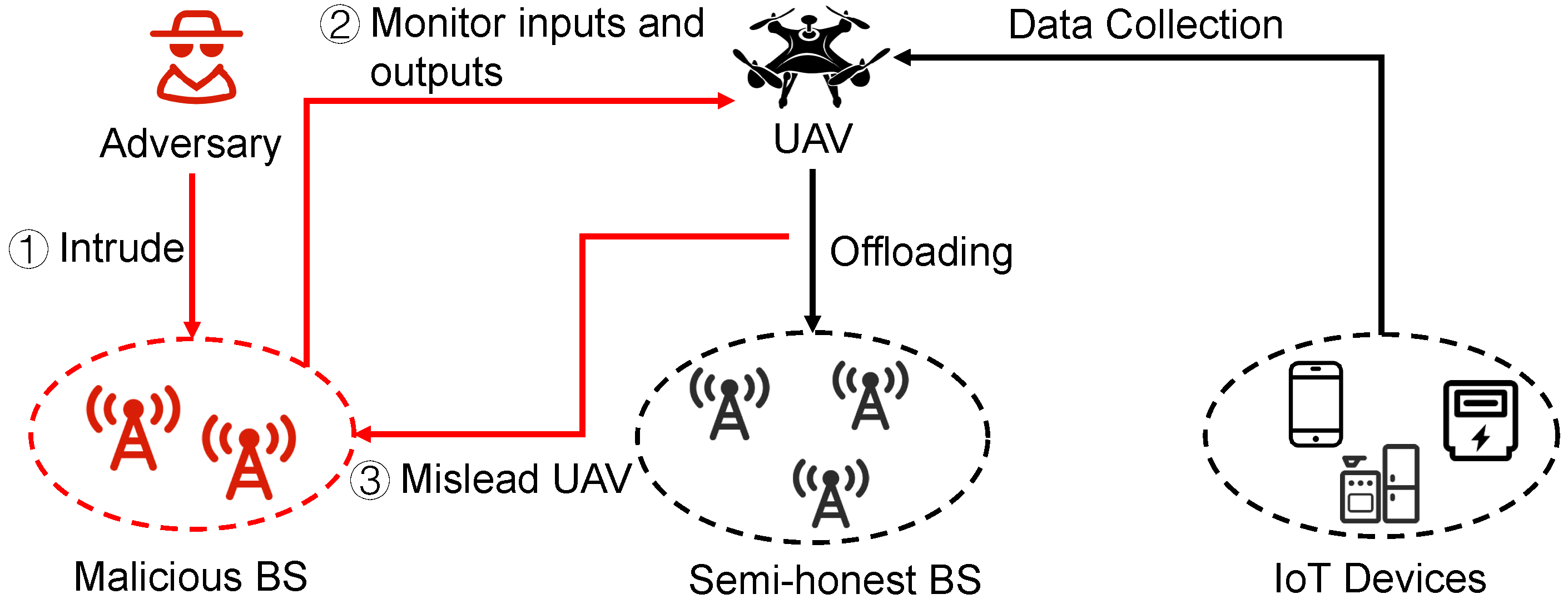
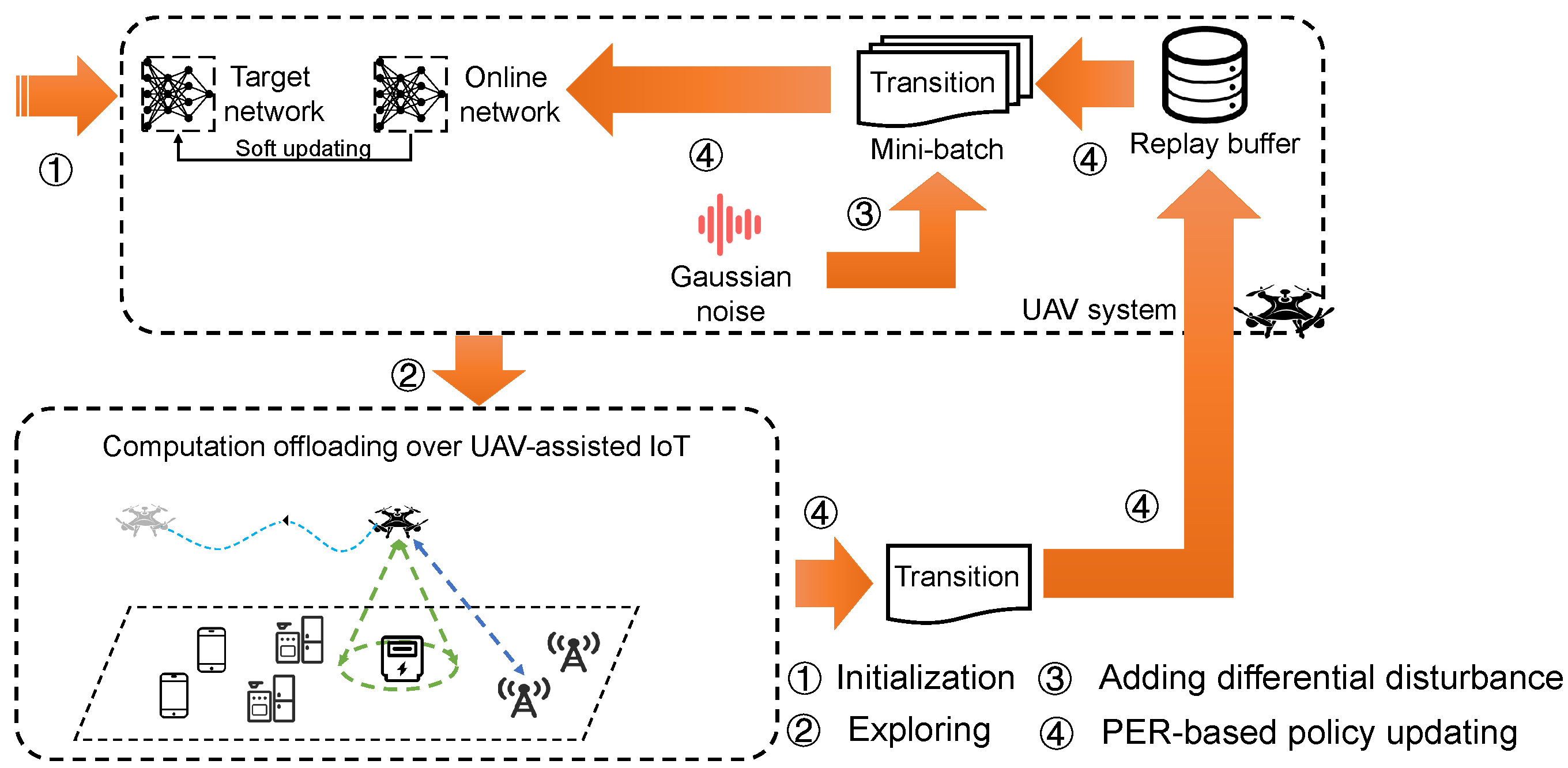
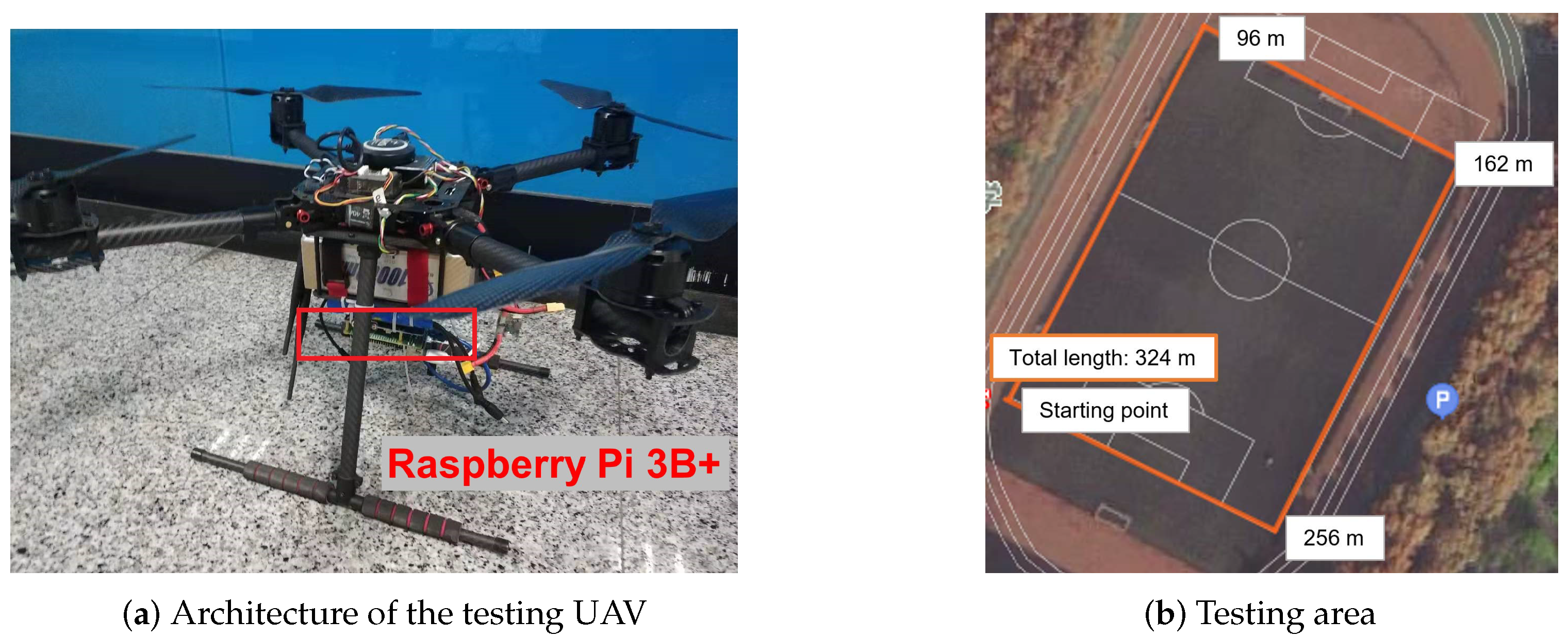
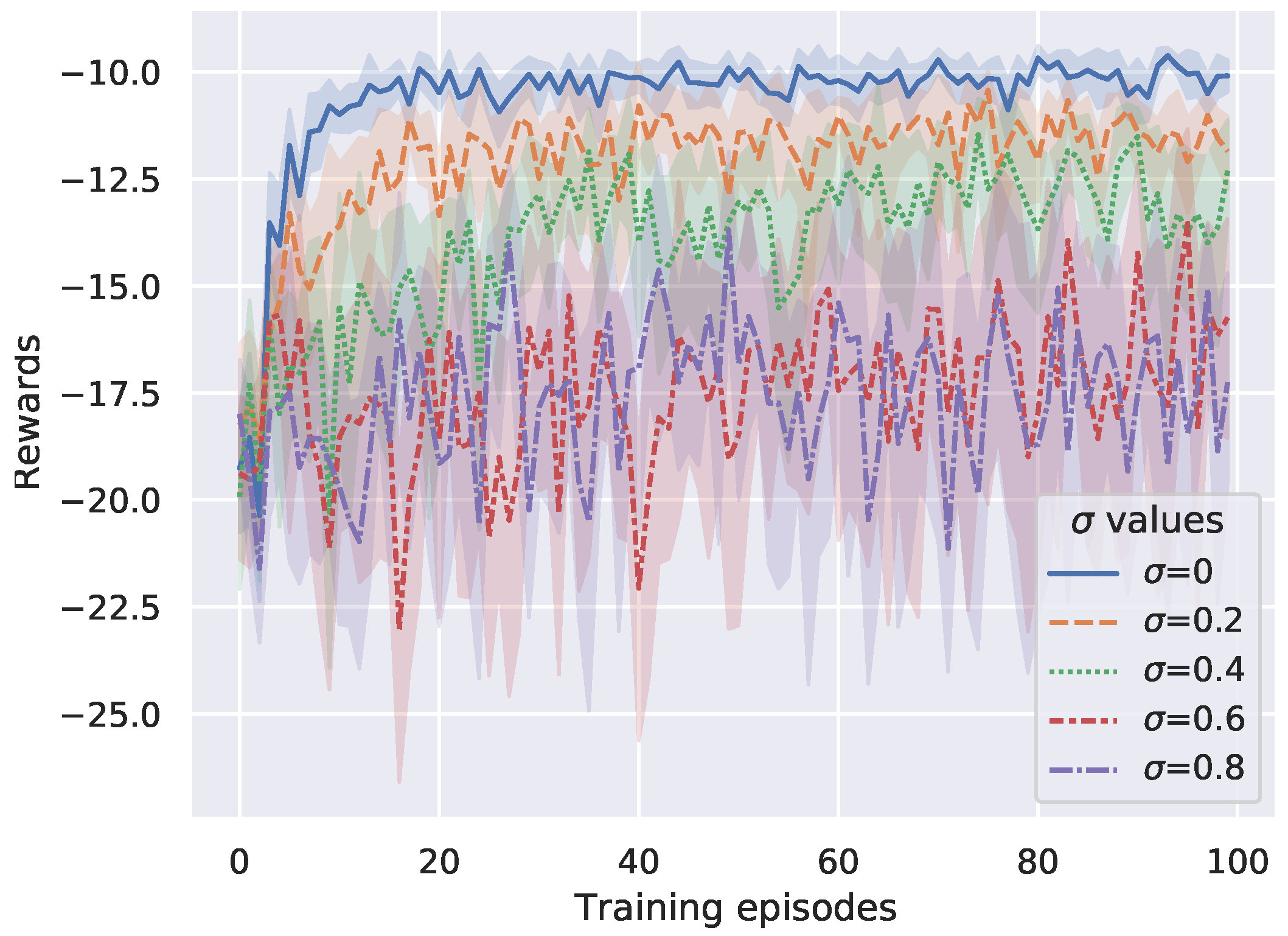




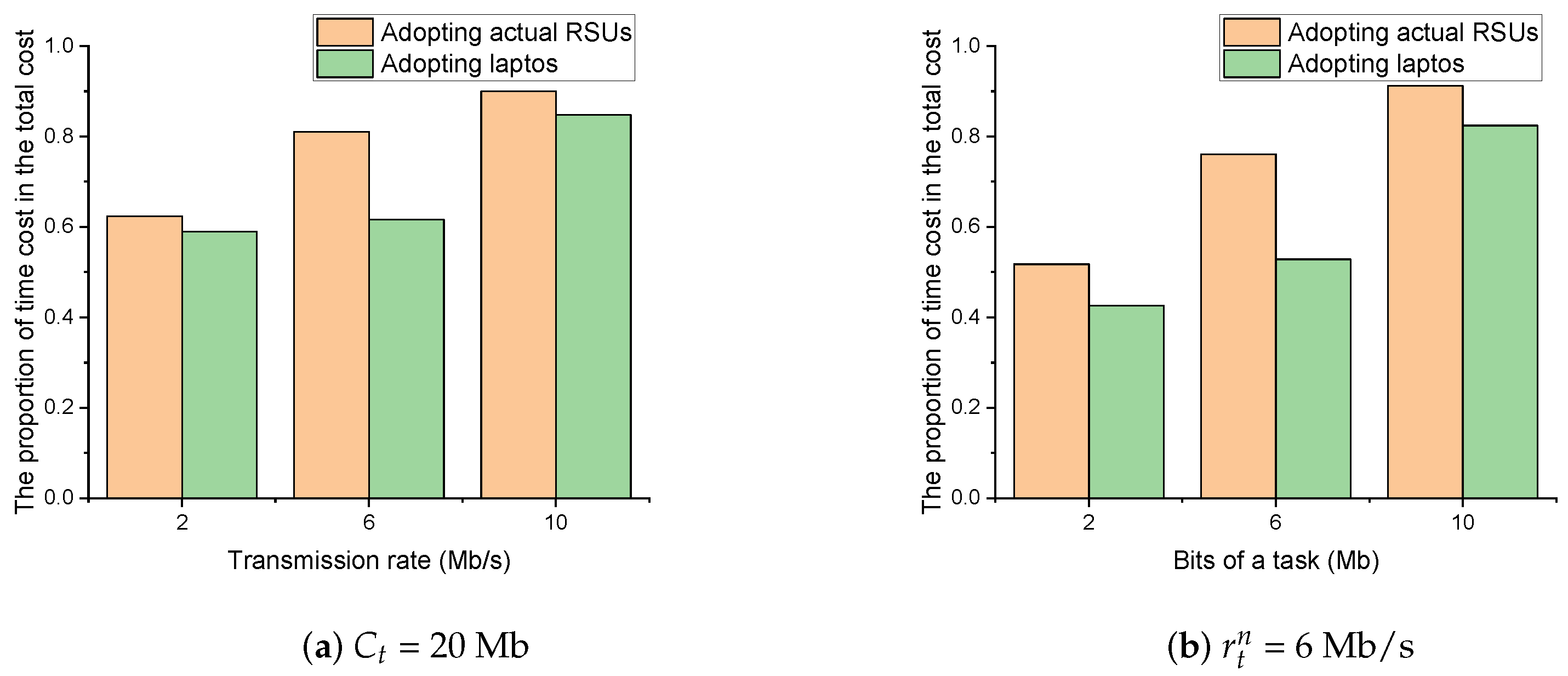
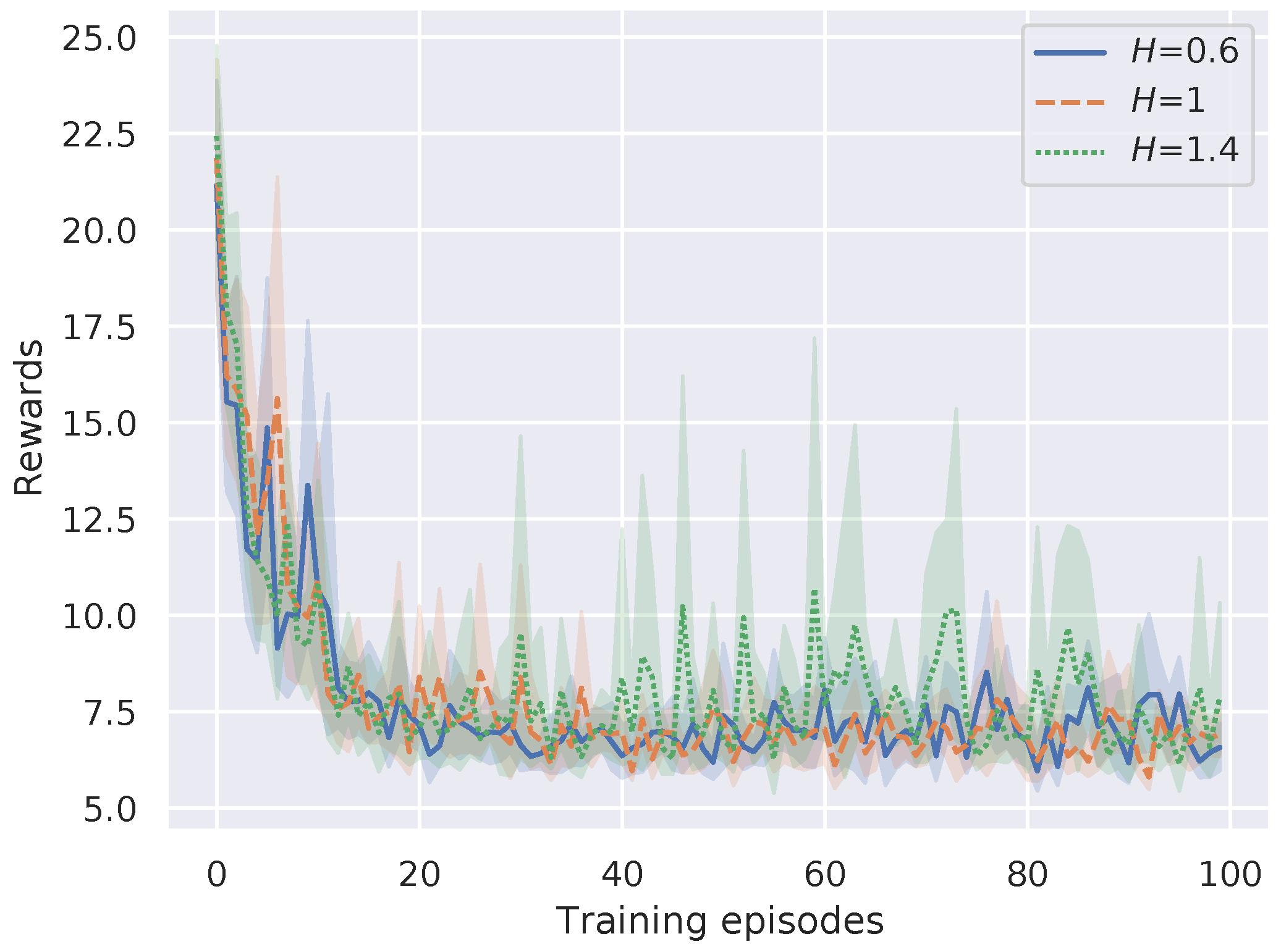
| Notations | Descriptions |
|---|---|
| n | The index of BSs |
| N | The number of BSs |
| The set of BSs | |
| The x-coordinate and y-coordinate of BS n | |
| The x-coordinate, y-coordinate, and height of UAV | |
| t | Time index |
| The CPU frequency of n-th BS | |
| f | The CPU frequency of the UAV |
| The computation task in time slot t and the set of computation task | |
| H | The reset factor of the DP-DQL |
| The time and energy consumption at time slot t in BSs | |
| The bits and maximum execution time of task | |
| The consumed time and energy to locally process task at time slot t | |
| The transmit power of transmitting a bit from BS n to the UAV | |
| The action, state, and reward of the DP-DQL in t-th time slot | |
| The number of training episode and the maximum learning steps within a training episode | |
| The discount factor and learning rate of the proposed DP-DQL | |
| The mini-batch size and the replay buffer | |
| The bits which be processed during a CPU cycle | |
| The radio link transmission rate between the UAV and BS n | |
| The balance factor of the DP-DQL |
| Parameter | Value | Parameter | Value |
|---|---|---|---|
| h | 5 m | {20, 40, 60} Mb | |
| f | cycles/s | cycles/s | |
| 3 s | 1000 | ||
| {2, 6, 10} Mb/s | |||
| 0.2 W | 100 | ||
| V | 50 | N | 3 |
| 0.001 | 0.999 | ||
| 0.5 | 0.5 | ||
| 1024 | A | 128 | |
| 0.5 | 0.5 |
| values | 0 | 0.2 | 0.4 | 0.6 | 0.8 | |
| p-values | 0.197 | 1.23 × 10 | 5.73 × 10 | 7.54 × 10 | 4.25 × 10 |
Publisher’s Note: MDPI stays neutral with regard to jurisdictional claims in published maps and institutional affiliations. |
© 2021 by the authors. Licensee MDPI, Basel, Switzerland. This article is an open access article distributed under the terms and conditions of the Creative Commons Attribution (CC BY) license (https://creativecommons.org/licenses/by/4.0/).
Share and Cite
Wei, D.; Xi, N.; Ma, J.; He, L. UAV-Assisted Privacy-Preserving Online Computation Offloading for Internet of Things. Remote Sens. 2021, 13, 4853. https://doi.org/10.3390/rs13234853
Wei D, Xi N, Ma J, He L. UAV-Assisted Privacy-Preserving Online Computation Offloading for Internet of Things. Remote Sensing. 2021; 13(23):4853. https://doi.org/10.3390/rs13234853
Chicago/Turabian StyleWei, Dawei, Ning Xi, Jianfeng Ma, and Lei He. 2021. "UAV-Assisted Privacy-Preserving Online Computation Offloading for Internet of Things" Remote Sensing 13, no. 23: 4853. https://doi.org/10.3390/rs13234853
APA StyleWei, D., Xi, N., Ma, J., & He, L. (2021). UAV-Assisted Privacy-Preserving Online Computation Offloading for Internet of Things. Remote Sensing, 13(23), 4853. https://doi.org/10.3390/rs13234853







